Sommelier Certification: Exploring The Wines Of Alsace, France
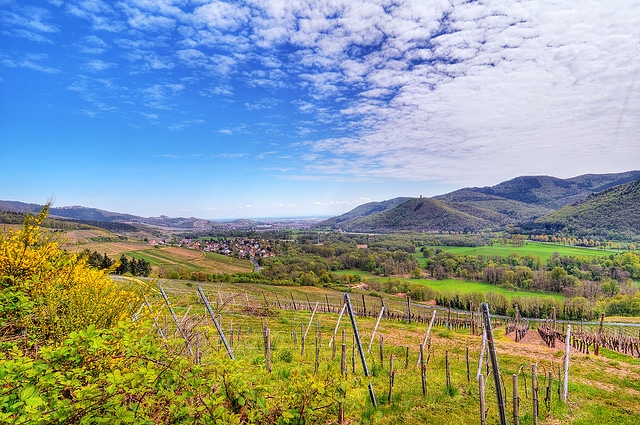
Alsace, France. Photo courtesy of Tambako The Jaguar.
"'The Queen of Riesling' — That's what I want it to say on my tombstone!" laughs Stephanie Frederick, my instructor for the day for my Sommelier Society of America sommelier certification. Not only does she hold a diploma from the Wine And Spirits Education Trust in London and the distinction of being the third woman to ever be inducted into the Bons Entonneurs de Rabelaisens in Chinon, France in 1984, but she's hysterical, and will be teaching today's class about the delicious wines of Alsace and the Loire Valley in France (although I'm saving The Loire for a separate post — stay tuned!) .
The "Queen of Riesling" joke stemmed from the fact Alsace is known for its dry Riesling, and anyone who thinks of this wine varietal as sweet will be immediately blown away drinking an Alsace Riesling. In fact, Riesling is often referred to as the "King of Alsace" (so I guess Ms. Frederick and her beloved wine will make a perfect royal couple).
Alsace is primarily known for its whites, which make up about 90% of the wine production in the region. This is because of the region's cool climate, which leads to less-ripe fruit that have less sugar and more acidity — perfect for adding a crispness to the palate. In order to balance this acidity, Alsace winemakers will use chaptalization, or the addition of sugar before fermentation to be converted in alcohol by yeast, which provides fullness and warmth.

Epicure & Culture editor Jessica Festa with Robert Ross Moody, Sommelier Society of America Chairman. Photo courtesy of Betty Pallis, Senior Program Coordinator of the Sommelier Society of America.
Unique Alsace
There are a few unique facets to this region. First, unlike the other wine regions in France, Alsace wines are labeled mainly by their grape variety. For most wine regions of France, terroir is thought to be the most important aspect of the winemaking. In fact, typically the laws of the French Appellation d'Origine Contrôlée (AOC) – a terroir-focused certification given to certain geographical regions in France in reference to agricultural products, like wine — prohibit the showcasing of the varietals on the labels; however, because of the region's German influence Alsace uses the German method of labeling. It's also worth noting that in Alsace winemakers must have 100% of the grape varietal listed on the wine bottle, as blends require a "Edelzwicker" or "Gentil" listing.
Additionally, when talking about Alsace wines one should not neglect to mention — or better yet, discuss in length — the local dry Rieslings. For those who believe sweet Riesling is all that's out there, or is all that needs to be out there, try an Alsace variety and have your mind blown. These complex dry wines offer a bright acidity — typical of dry wines as sugar and acid counteract each other — and often intense minerality and fruit flavors. Moreover, moderate alcohol levels offer a rich texture.
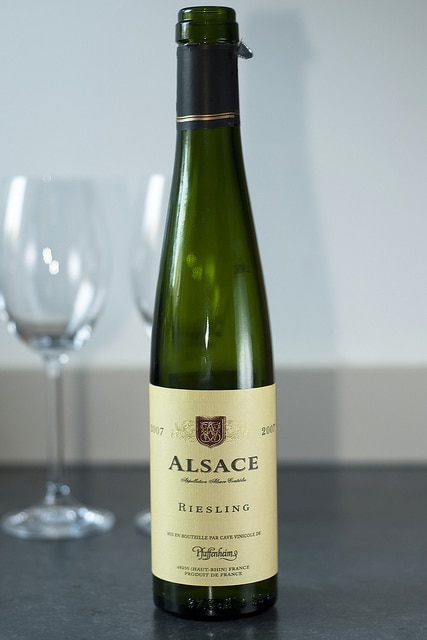
Alsace Riesling. Photo courtesy of Michal Osmenda.
If you have one wine while in Alsace, make it a dry Riesling; however, I'm not sure why in a region that produces such aromatic and balanced ripe fruit wines someone would only try one. The region also produces reds, whites, roses and sparkling varieties through three AOCs: Alsace AOC, Alsace Grand Cru AOC and Crémant d'Alsace AOC. Alsace AOC makes up most of the region's wines — mainly still whites — with the main grapes being Riesling, Gewürztraminer, Pinot Gris, Muscat, Pinot Blanc, Sylvaner and Pinot Noir. Through this appellation you can savor one of the world's most unusual yet delightful wines, Pinot d'Alsace, a blend of Pinot Blanc, Pinot Gris, Auxerrois and Chardonnay, all Pinot grapes that are related through genetic mutations and hybridization. Featuring aromas of green apple with a touch of honey and flavors of ripe fruit, crystallized ginger, cloves and grapefruit, this complex slightly smokey and spicy wine is a must-try.
Side Note: According to Ms. Frederick, too many people believe California is the epicenter of the wine world, and begin to think the wines they're producing as the standards. Just sample a Pinot Noir from California and a Pinot Noir from Alsace and you'll quickly see there's a whole big world of wine out there. While a California Pinot Noir tends to be more intense in flavor and fruit forward due to the warm climate and local soils the grapes are grown in, Alsace Pinot Noirs are high in acidity and with discreet tannins.
Alsace Grand Cru AOC refers to white wines from 51 individual vineyard sites. The laws for these wines are strict, and wines must be made using one of the four "Nobel Grapes of Alsace," including Muscat, Pinot Gris, Riesling or Gewürztraminer. Yield specifications are lower and minimum alcohol levels higher than with Alsace AOC. This means lots of sun for ripe fruit is needed, leading to wines that are rich with flavors of honey (whether sweet or dry) and minerality that reflects the terroir they're grown in. While these make up only a small portion of Alsatian wines — about 4% — you'll typically be getting very high quality.
And for those who enjoy sparkling wine, Crémant d'Alsace AOC is made using the same methods as Champagne — although to be called Champagne a sparkling wine must be made in Champagne, France. For the white, Riesling, Pinot Blanc, Pinot Gris, Pinot Noir, Auxxerois, and even sometimes Chardonnay grapes are used, while their sparkling rose is composed of 100% Pinot Noir. Typically grapes are picked early in the harvest for a fresh and elegant drink.
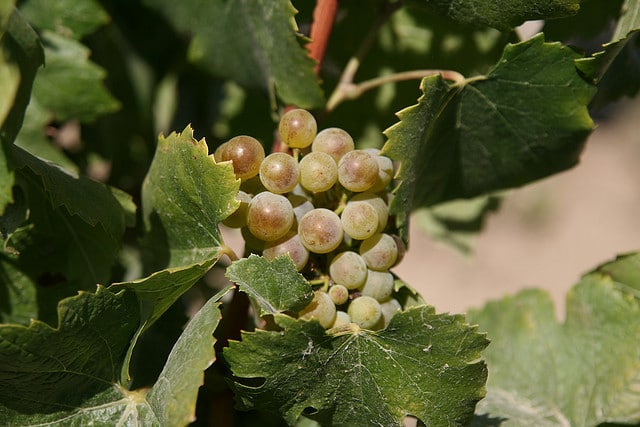
Riesling grapes. Photo courtesy of Bernt Rostad.
Mind Blown
One major pet peeve of Ms. Frederick's is when people automatically associate sweet wines with Beringer White Zinfandel and think it's something drank by those on a serious budget or with no taste. With a serious look in her eye, she proclaimed loudly, "There are so many great sweet wines out there like Hungarian Tokaji or those produced by Klein Constantia in South Africa. I'm telling you, sweet wine can be cool!"
One of the regions where sweet wine is "cool" is Alsace, which is know for its sweet winemaking methods, including Vendange Tardive and Sélection de Grains Nobles. Vendange tardive translates to "late harvest" in French, and the grapes hang on the vine until they begin to dehydrate for more concentrated sugars that lead to a delicious dessert wine. It's made using one of Alsace's four Nobel Grapes of Alsace. There's also Sélection de Grains Nobles, wine made from berry-by-berry picked botrytis grapes, or grapes affected by grey fungus that shrivels and dehydrates the grapes. Yes, you read that right. Sometimes, winemakers actually want their grapes to rot, as botrytis can add flavor and intensify sweetness.
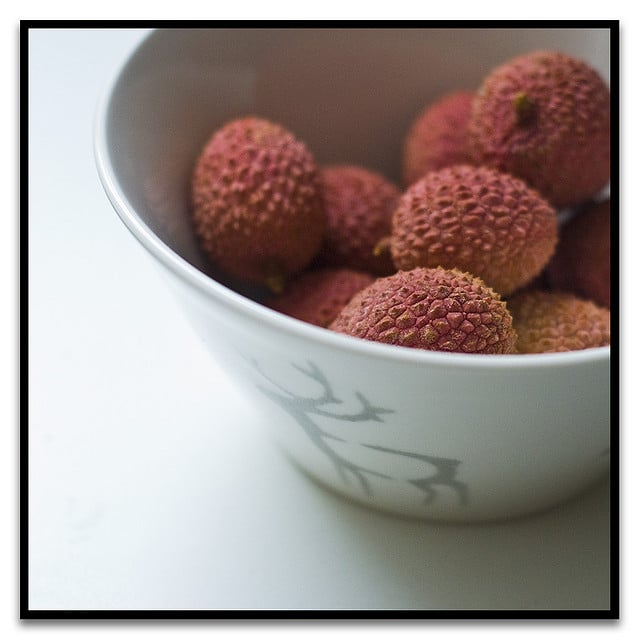
The distinct aroma of lychee fruit is typical of Alsace Gewürztraminer. Photo courtesy of John Loo.
The Tasting
In terms of the tasting, the Alsatian wines we tried included a 2012 Jean Ginglinger Pinot Blanc "Cuvee George"; a 2011 Riesling Grand Cru "Frankstein" Manbach; and a blind tasting. We started with the blind tasting, first looking at the color of the wine — a golden yellow — before inhaling its aromas. There was a distinct smell of lychees, rose petal and grapefruit. As for the taste, it felt full-bodied and tasted off-dry with a slight acidity. This is an exact description for an Alsace Gewürztraminer, which tends to have exotic fruit qualities and a slight spice (not to mention Gewürztraminer is one of the region's most popular grapes).
For the Pinot Blanc, I immediately noticed the golden color and floral aromas. As I let the off-dry, slightly creamy wine envelop my palate, I tasted delicious fruit-forward notes of peach and melon (and with such a snowy winter in my home of New York City it made me crave summer). What's really great about this wine, as I learned in the class, is it delivers value at approximately $15. The wine offers a higher quality than the price tag would leave you to believe. This is because Alsace is known for its Riesling, although just because the region's Pinot Blanc isn't as popular doesn't mean it isn't as good.
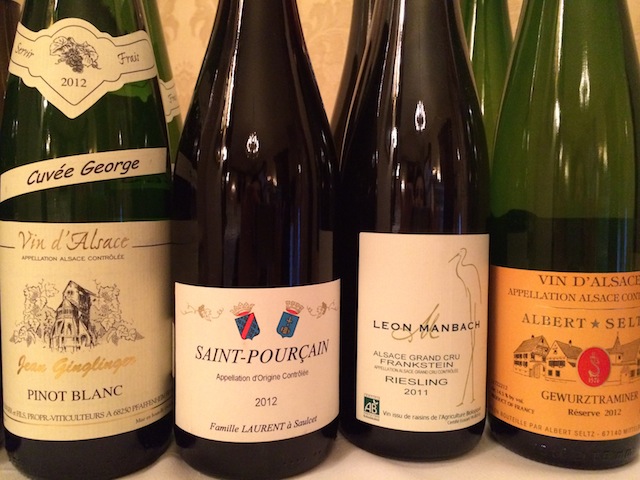
A look at the wine's we tasted for the Alsace portion of the course. Photo courtesy of Betty Pallis is the Senior Program Coordinator of the Sommelier Society of America.
Finally, the dry Riesling offered flowers and peach blossom on the nose, a granite minerality with bright acidity, and flavors of pure citrus.
I'll admit, as someone who is used to drinking sweet Rieslings, I left the class excited to hit the local wine shop — especially as both of these last Alsatian wines are under $20!
For more wine education, subscribe to our RSS feed and follow our original series, Sommelier Certification.
Have you sampled Alsace wines or visited the French wine region? What do you recommend? What was your experience like? Please share in the comments below.
The post Sommelier Certification: Exploring The Wines Of Alsace, France appeared first on Epicure & Culture.